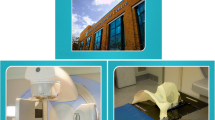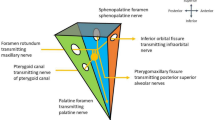Abstract
The aim of this study was to investigate if teaching patients about positioning before radiotherapy treatment would (a) reduce the residual rotational set-up errors, (b) reduce the number of repositionings and (c) improve patients’ sense of control by increasing self-efficacy and reducing distress. Patients were randomized to either standard care (control group) or standard care and a teaching session combining visual aids and practical exercises (intervention group). Daily images from the treatment sessions were evaluated off-line. Both groups filled in a questionnaire before and at the end of the treatment course on various aspects of cooperation with the staff regarding positioning. Comparisons of residual rotational set-up errors showed an improvement in the intervention group compared to the control group. No significant differences were found in number of repositionings, self-efficacy or distress. Results show that it is possible to teach patients about positioning and thereby improve precision in positioning. Teaching patients about positioning did not seem to affect self-efficacy or distress scores at baseline and at the end of the treatment course.

Similar content being viewed by others
References
Grau C, Defourny N, Malicki J, Dunscombe P, Borras JM, Coffey M, Slotman B, Bogusz M, Gasparotto C, Lievens Y (2014) Radiotherapy equipment and departments in the European countries: final results from the ESTRO-HERO survey. Radiother Oncol 112:155–164
van Herk M (2004) Errors and margins in radiotherapy. Semin Radiat Oncol 14:52–64
Laursen LV, Elstrom UV, Vestergaard A, Muren LP, Petersen JB, Lindegaard JC et al (2012) Residual rotational set-up errors after daily cone-beam CT image guided radiotherapy of locally advanced cervical cancer. Radiother Oncol 105:220–225
Bujold A, Craig T, Jaffray D, Dawson LA (2012) Image-guided radiotherapy: has it influenced patient outcomes? Semin Radiat Oncol 22:50–61
Rönning H, Nielsen NE, Strömberg A, Thilen U, Swahn E (2013) Development and evaluation of a computer-based educational program for adults with congenitally malformed hearts. Eur J Cardiovasc Nurs 12:78–86
Morley L, McAndrew A, Tse K, Rakaric P, Cummings B, Cashell A (2013) Patient and staff assessment of an audiovisual education tool for head and neck radiation therapy. J Canc Educ 28:474–480
Marini BL, Funk K, Kraft MD, Fong JM, Naanos R, Stout SM, Wagner D (2014) The effects of an informational video on patient knowledge, satisfaction and compliance with venous thromboembolism prophylaxis: a pilot study. Patient Educ Couns 96:264–267
Sulé-Suso J, Finney S, Bisson J, Hammersley S, Jassel S, Knight R et al (2015) Pilot study on virtual imaging for patient information on radiotherapy planning and delivery. Radiography 21:273–277
Bol N, Smets EM, Rutgers MM, Burgers JA, de Haes HC, Loos EF, van Weert JC (2013) Do videos improve website satisfaction and recall of online cancer-related information in older lung cancer patients? Patient Educ Couns 92:404–412
Meldrum D, Herdman S, Vance R, Murray D, Malone K, Duffy D et al (2015) Effectiveness of conventional versus virtual reality-based balance exercises in vestibular rehabilitation for unilateral peripheral vestibular loss: results of a randomized controlled trial. Arch Phys Med Rehabil 96:1319–1328
Cuthbert JP, Staniszewski K, Hays K, Gerber D, Natale A, O’Dell D (2014) Virtual reality-based therapy for the treatment of balance deficits in patients receiving inpatient rehabilitation for traumatic brain injury. Brain Inj 28:181–188
Tortella-Feliu M, Botella C, Llabrés J, Bretón-López JM, del Amo AR, Baños RM, Gelabert JM (2011) Virtual reality versus computer-aided exposure treatments for fear of flying. Behav Modif 35:3–30
Hoffman AJ, Brintnall RA, Brown JK, von Eye A, Jones LW, Alderink G et al (2014) Virtual reality bringing a new reality to postthoracotomy lung cancer patients via a home-based exercise intervention targeting fatigue while undergoing adjuvant treatment. Canc Nurs 37:23–33
Garcia-Palacios A, Herrero R, Vizcaíno Y, Belmonte MA, Castilla D, Molinari G et al (2015) Integrating virtual reality with activity management for the treatment of fibromyalgia: acceptability and preliminary efficacy. Clin J Pain 31:564–572
Bandura A (1997) Self-efficacy: the exercise of control. W. H. Freeman, New York
Cunningham AJ, Lockwood GA, Cunningham JA (1991) A relationship between perceived self-efficacy and quality of life in cancer patients. Patient Educ Couns 17:71–78
Boejen A, Grau C (2011) Virtual reality in radiation therapy training. Surg Oncol 20:185–188
Phillips R, Ward JW, Beavis AW (2005) Immersive visualization training of radiotherapy treatment. In: Westwood JD, Haluck RS, Hoffman HM (eds) Studies in health technology and informatics: medicine meets virtual reality 13: the magical next becomes the medical now. IOS Press, Amsterdam, Washington, DC, pp. 390–396
Thalén-Lindström A, Larsson G, Hellbom M, Glimelius B, Johansson B (2013) Validation of the distress thermometer in a Swedish population of oncology patients; accuracy of changes during six months. Eur J Oncol Nurs 17:625–631
Sellick SM, Edwardson AD (2007) Screening new cancer patients for psychological distress using the hospital anxiety and depression scale. Psychooncology 16:534–542
Ibbotson T, Maguire P, Selby P, Priestman T, Wallace L (1994) Screening for anxiety and depression in cancer patients: the effects of disease and treatment. Eur J Canc 30:37–40
Cronbach LJ (1951) Coefficient alpha and the internal structure of tests. Psychometrika 16:297–334
Fan S, Su F, Chen S, Hou W, Sun J, Chen K et al (2014) Improved intrinsic motivation and muscle activation patterns in reaching task using virtual reality training for stroke rehabilitation: a pilot randomized control trial. J Med Biol Eng 34:399–407
Levin MF, Snir O, Liebermann DG, Weingarden H, Weiss PL (2012) Virtual reality versus conventional treatment of reaching ability in chronic stroke: clinical feasibility study. Neurol Ther 1:1–15
Acknowledgments
This project was made possible as part of the course ‘Research Methodology for Radiation Therapist’, a project-based course in the Department of Oncology at Aarhus University Hospital. The Unit for Psycho-oncology and Health Psychology at Aarhus University Hospital and Aarhus University assisted in developing the questionnaire.
Author information
Authors and Affiliations
Corresponding author
Ethics declarations
Ethics
The project coordinator met with potential patients at their first visit at the radiotherapy unit to screen for eligibility, inform about the study and obtain informed consent. The project was approved by the regional Danish data protection agency in Central Denmark Region (journal number 2007-58-0010). Informed consent was obtained from all participants before inclusion.
Conflict of Interest
The authors declare that they have no conflict of interest.
Rights and permissions
About this article
Cite this article
Hansen, H., Nielsen, B.K., Boejen, A. et al. Teaching Cancer Patients the Value of Correct Positioning During Radiotherapy Using Visual Aids and Practical Exercises. J Canc Educ 33, 680–685 (2018). https://doi.org/10.1007/s13187-016-1122-2
Published:
Issue Date:
DOI: https://doi.org/10.1007/s13187-016-1122-2




